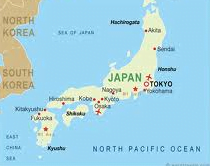From the UN Office for the Coordination of Humanitarian Affairs most recent situation update on the crisis in Japan.
Casualties
28,550 dead or missing with 10,901 confirmed deaths and 17,649 reported as missing. In the 3 hardest-hit prefectures, Miyagi, Iwate and Fukushima, it is estimated that more than 230 school children (7-18 years old) have died and 885 are missing.
Debris Removal
In Miyagi alone, the debris amounts to roughly 15 to 18 million tons, which is equivalent to 23 years worth of waste for the prefecture. It only has the capacity to dispose of 0.8 million tons per year. Authorities say it will take three years to remove all the debris and this does not include cars and boats. The Government says it plans to cover most of the removal costs.
Water and Sanitation
The Emergency Disaster Response Headquarters says approximately 4.3 million bottles of water have been delivered to evacuation centres in the affected areas so far. Water supply to 170,000 households has improved since 25 March, but 490,000 households still remain without water in 10 prefectures (50,000 in Iwate, 330,000 households in Miyagi and 50,000 households in Fukushima). Furthermore, the Ministry of Health, Labour and Welfare is coordinating with water supply companies to provide emergency water to the affected areas. 488 water trucking vehicles are currently on the ground with 213 vehicles in Miyagi, 39 in Fukushima, and 82 in Iwate.
According to the Ministry of Land, Infrastructure, Transport and Tourism 15 sewage systems are not functioning or damaged in Iwate, 59 in Miyagi, and 14 in Fukushima. This is a slight improvement in Iwate and Fukushima.
International Response
Individuals and private sector companies, along with countries and aid organizations, have contributed and pledged a total of US$545 million bilaterally to the Government of Japan, Red Cross Societies, NGOs and other partners to support the immediate relief efforts, according to the Financial Tracking Service. More than 86 per cent of the contributions are funds raised from the private sector.
